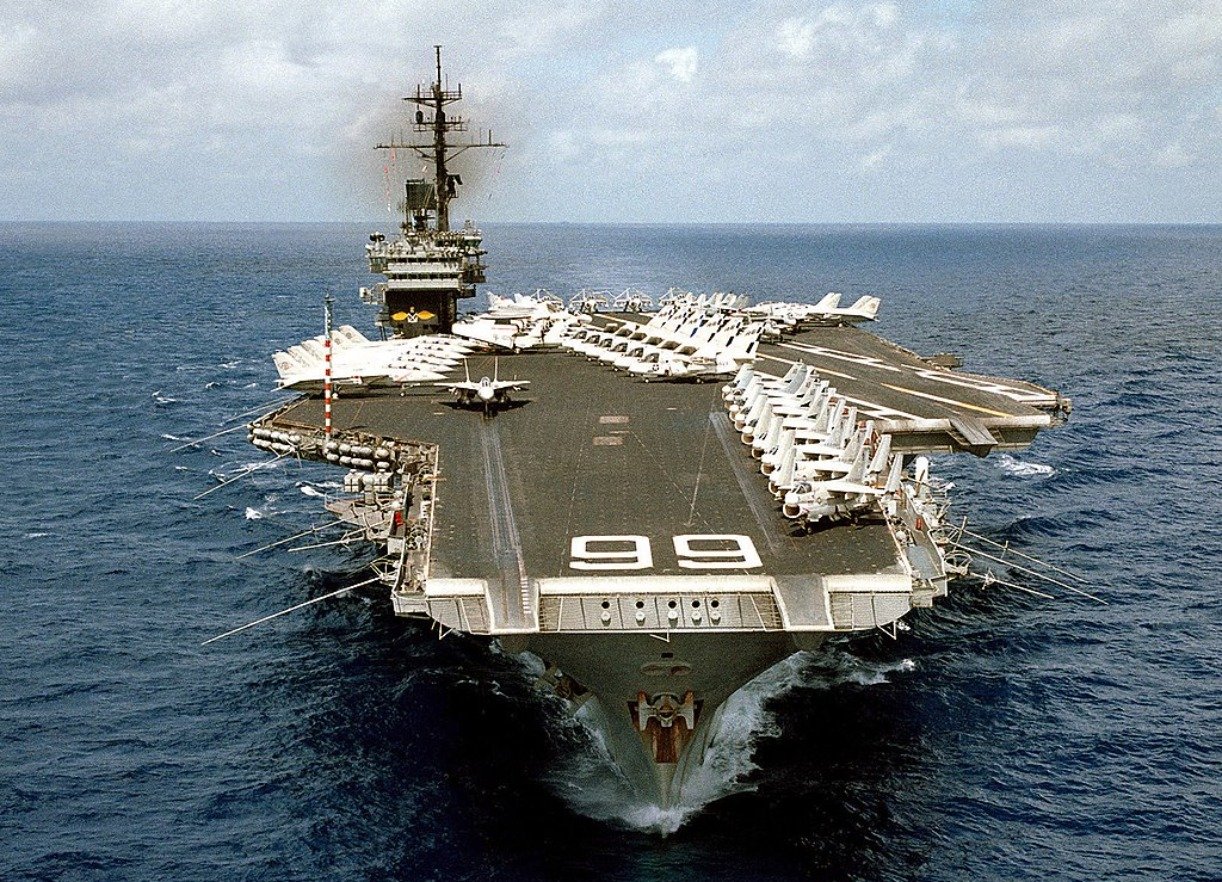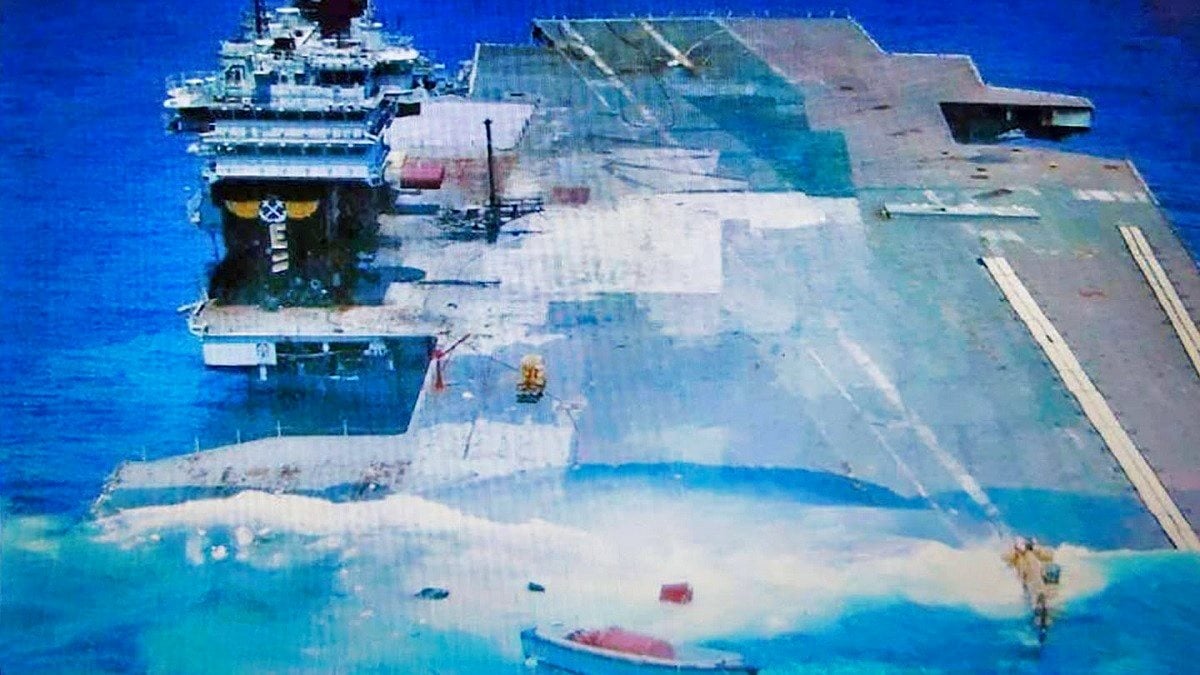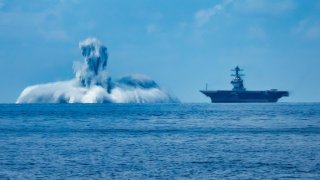The U.S. Navy Decided to Sink Its Own Aircraft Carrier
The USS America (CV-66), a conventionally-powered Kitty Hawk-class aircraft carrier, served the U.S. Navy from 1965 to 1996. Known as "Big A," the ship played significant roles in the Vietnam War, the Six-Day War, Operation Eagle Claw, and Operation Desert Storm, among others.
Summary and Key Points: The USS America (CV-66), a conventionally-powered Kitty Hawk-class aircraft carrier, served the U.S. Navy from 1965 to 1996. Known as "Big A," the ship played significant roles in the Vietnam War, the Six-Day War, Operation Eagle Claw, and Operation Desert Storm, among others.

-Despite her stellar service record, she met an unfortunate end when she was deliberately sunk during a U.S. Navy exercise in 2005.
-The data gained from her sinking provided valuable insights into carrier survivability, but many believe the legendary vessel deserved a better fate, possibly as a museum to honor her contributions.
USS America (CV-66) was a Legend
The USS America (CV-66) was a conventionally-powered Kitty Hawk-class aircraft carrier that served the United States Navy from 1965-1996. She was built by Newport News Shipbuilding and Dry Dock Company and was initially based in Norfolk, Virginia. This warship would go on to provide stellar service to her country.
She was known as “Big A” by her crew and the ship’s official motto was “Don’t Tread On Me.”
“Big A” Service Record
In terms of CV-66, she served in the Vietnam War. This carrier was used to launch airstrikes against targets deep inside North Vietnam. Indeed, according to MilitaryFactory.com, the USS America, living up to her great name, “performed to mythical standards,” as the America never lost any of her pilots in air combat over the unfriendly skies of Indochina. Indeed, a whopping 11,000 tons of ordnance over 10,500 sorties, were dropped on Vietcong targets.
After the Vietnam War, the USS America (CV-66) was not done serving. During the Six-Day War between Israel and its Arab neighbors, the America was deployed to the Mediterranean Sea as part of a larger US Navy flotilla. That flotilla included the infamous USS Liberty. Still a controversy today, the USS Liberty was conducting surveillance of the ongoing Israel-Arab war in 1967 near the warzone when, according to the official account, Israeli warplanes misidentified the American warship for an enemy one and ordered the destruction of the boat. Israeli torpedo boats attacked the American ship, killing thirty-four US sailors and injuring another seventy-five.
Once word got out to the US fleet that Liberty was under attack, America’s airwing went into action, providing support for the stricken warship.
She also participated in the failed Operation Eagle Claw, which was President Jimmy Carter’s shambolic attempt to free the captured American hostages in Iran. It failed, to the chagrin and shame of everyone involved.
Multiple operations thereafter demanded the carrier’s time and attention, such as the Reagan administration’s mini-war with Muammar Gaddafi’s Libya. America supported multiple engagements against the Libyan military during the 1980s.
Notably, CV-66 was involved with Operation Desert Storm in 1991. This boat provided important aerial support for the US forces fighting against the Iraqi Army in the mission to liberate Kuwait from Iraq’s illegal invasion. America would launch 3,000 sorties throughout the war. In the 1990s, her last decade of service, she supported the enforcement of the No-Fly Zones over Iraq and participated in the Clinton administration’s air war over Bosnia.
Her Design
CV-66 was a fairly common-looking US aircraft carrier with a familiar design. It had a starboard island and an angled deck with three catapults for launching warplanes. Four hangar elevators serviced the flight deck. She carried a whopping seventy-nine aircraft, both fixed-wing and rotorcraft, making her a potent asset on the battlefield. The aircraft that comprised her airwing included the likes of the legendary F-4 Phantoms, A-6 Intruders, A-7 Corsair IIs, and SP-2 Neptunes.
This boat was not without defenses. America had an electronic countermeasures suite that included the Raytheon-built AN/SLQ-32. At first, the old Terrier missiles were included in the warship’s armaments package. Eventually, these were swapped out for the Sea Sparrow surface-to-air missiles. Three, 20mm Phalanx Close-In Weapon Systems (CWIS) were installed to further assist with anti-aircraft and anti-missile defense.
USS America: She Deserved Better
This legendary boat, unfortunately, met an ignominious end.
Rather than be preserved as a museum, she was ultimately sent to the bottom of the drink. No, the USS America was not sunk in combat with one of America’s enemies. The great ship was sunk during an exercise in which she was the target practice by US forces back in 2005.
It was a tragic end to a legendary ship.
At the same time, though, it should be noted that the American sinking of the USS America (CV-66) allowed the US military to learn crucial information about how aircraft carriers can survive a serious fight—and how long it takes for these behemoths to go under the waves.
That information, while still classified, remains an important set of data points for the US Navy to incorporate in the designs and operations of their current fleet of Nimitz-class and Gerald R. Ford-class aircraft carriers.
After all, America’s enemies are deeply wedded to the notion of sinking US carriers in combat. Especially China. By sinking the America during a test, the Navy was able to learn about some of the weaknesses of its carrier fleet and could have conceivably mitigated the threat those weaknesses posed.

The Navy brass insisted that the USS America died as she lived: serving the US Navy. However, one cannot help but think that this glorious warship was wasted.
By sinking her in a test the Navy did learn some interesting tidbits. But she deserved better. This was most obvious considering her stellar service record across thirty years.
Author Experience and Expertise: Brandon J. Weichert
Brandon J. Weichert, a National Interest national security analyst, is a former Congressional staffer and geopolitical analyst who is a contributor at The Washington Times, the Asia Times, and The-Pipeline. He is the author of Winning Space: How America Remains a Superpower, Biohacked: China’s Race to Control Life, and The Shadow War: Iran’s Quest for Supremacy. His next book, A Disaster of Our Own Making: How the West Lost Ukraine, is due October 22 from Encounter Books. Weichert can be followed via Twitter @WeTheBrandon.
All images are Creative Commons or Shutterstock. Main image is of a Ford-Class carrier under shock test.
From the Vault
Russia Freaked Out: Why the U.S. Navy 'Unretired' the Iowa-Class Battleships
Battleship vs. Battlecruiser: Iowa-Class vs. Russia's Kirov-Class (Who Wins?)
Image Credit: Creative Commons and/or Shutterstock.


